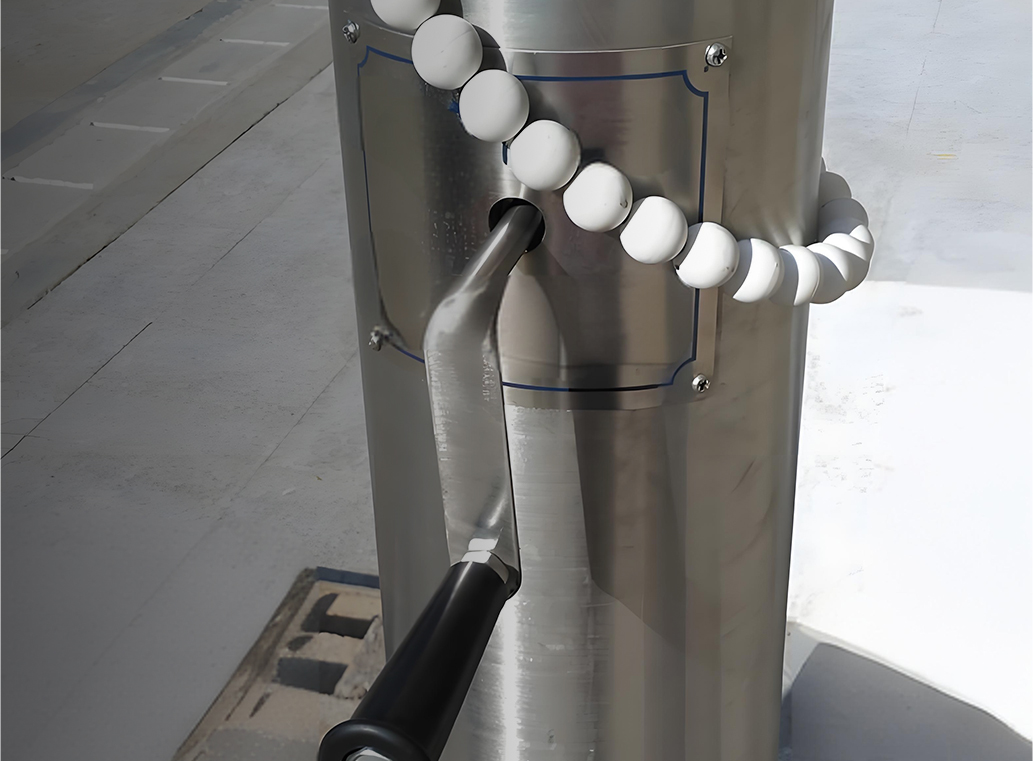Flagpoles stand as proud symbols, gracing homes, businesses, and public spaces alike. While various materials are used in their construction, stainles......
READ MORESubmit feedback
What is the maintenance process for an Aluminum Alloy Flagpole?
1. Understanding the Importance of Regular Maintenance for Aluminum Alloy Flagpoles
Regular maintenance of your aluminum alloy flagpole is essential for preserving its structural integrity, ensuring it remains aesthetically pleasing, and extending its overall lifespan. While aluminum is known for its durability and resistance to corrosion, it is not impervious to the effects of weather, wear, and environmental factors. A flagpole that is regularly maintained will perform better, last longer, and look more polished, thus minimizing the likelihood of costly repairs or replacements. The process of maintaining an aluminum flagpole goes beyond simple cleaning; it involves periodic checks, surface treatments, and proper upkeep to ensure that all components function as they should. One of the most significant reasons for conducting regular maintenance is safety. Flagpoles are often tall and may be placed in public spaces or near structures where failure could pose a hazard to people or property. By inspecting and maintaining the flagpole regularly, potential weaknesses, such as loose parts or damaged sections, can be addressed before they lead to more serious issues, such as a collapse or broken flagpole.
In addition to safety, maintaining the flagpole helps preserve its functionality. Over time, environmental elements like wind, rain, UV rays, and even salty air (in coastal areas) can wear down the flagpole’s exterior. If not cared for, this can lead to issues such as oxidation, rust, and surface deterioration, which could impede the flagpole’s ability to display flags properly or damage the flags themselves. Regular maintenance also helps the flagpole retain its aesthetic appeal. A well-maintained flagpole with a shiny, polished surface will stand out and improve the visual appeal of the area it’s located in. Neglecting this upkeep can lead to an unsightly, corroded, or dull-looking flagpole, which detracts from its intended purpose of showcasing flags in an elegant manner. Another key factor is that regular maintenance prevents minor issues from becoming major problems. For example, a small crack or chip can eventually grow larger and affect the overall structural integrity of the flagpole. If left unchecked, this can lead to a more costly and time-consuming repair or even a complete replacement. Therefore, addressing these minor concerns early on can save both time and money in the long run. Seasonal changes and extreme weather conditions place additional stress on your flagpole. Strong winds, snow, rain, and temperature fluctuations can weaken the material and hardware over time. By maintaining the flagpole according to the season and environmental conditions, it can be better protected from damage.
Regular inspections help ensure that the flagpole remains sturdy, especially in areas prone to strong winds or heavy storms. This process also aids in preserving the functionality of the supporting hardware, such as ropes, pulleys, and fasteners, which are subjected to constant stress and wear. Maintaining these components ensures smooth operation and minimizes the risk of operational failures. Regular maintenance also ensures the longevity of the flagpole by providing the necessary protection against corrosion and wear. For example, applying a protective coating or wax layer every few years helps shield the aluminum from the elements. Without such preventive measures, the flagpole can develop pits, scratches, or oxidation, which ultimately affect its durability.
Keeping the flagpole in good condition is also essential for maintaining a professional image, especially for businesses or organizations that use flagpoles for branding purposes. A well-maintained flagpole reflects attention to detail and commitment to quality, while a neglected one can make the establishment look unkempt or poorly managed. Finally, maintaining the flagpole is not only about protecting the flagpole itself but also ensuring that the flags it supports are properly displayed. A clean and functional flagpole ensures that flags fly freely and with dignity, which is especially important for ceremonial or national flags. It enhances the symbolism and respect associated with the flag being displayed, ensuring that it is shown with the proper level of care and attention.
2. Inspecting Your Aluminum Alloy Flagpole: Step-by-Step Guide
Regular inspection is the foundation of any flagpole maintenance routine. A well-timed, thorough inspection helps to identify and address any issues before they evolve into larger problems. Below is a step-by-step guide to inspecting your aluminum alloy flagpole, ensuring that it remains in optimal condition.
The first step in inspecting your flagpole is to conduct a visual inspection from top to bottom. Begin by standing at a distance and examining the overall condition of the pole. Look for any visible signs of cracks, dents, or bent sections. This can be particularly important for taller poles, as they are more prone to structural damage from extreme weather conditions, such as high winds or heavy storms. Check for any unusual bulges or kinks, as these could indicate that the flagpole has been subjected to stress or external forces that have compromised its integrity. If you notice any damage, make a note of it and assess whether it requires immediate attention or can be deferred until a later maintenance session.
Next, check for signs of corrosion. Aluminum is generally resistant to rust, but it can still suffer from corrosion, especially in coastal areas where saltwater exposure is common. Corrosion can manifest as discoloration, pitting, or a chalky white film on the surface of the pole. This is often an early indication that the protective oxide layer of the aluminum has been compromised. If you observe any signs of corrosion, it’s important to act quickly to clean the pole and reapply protective coatings to prevent the issue from worsening. In cases of more severe corrosion, the pole may need to be professionally treated or replaced.
Another critical area to examine is the foundation. The base of the flagpole is often exposed to the elements, and over time, erosion or shifting ground conditions can affect its stability. Inspect the ground around the flagpole’s base for signs of settling or loosening. If the flagpole is not anchored properly, it could become unstable and pose a safety risk. Gently shake the pole to see if it wobbles or shifts. If you notice any movement, you may need to reinforce the foundation or re-anchor the pole. It’s especially important to check the base after significant weather events like storms or earthquakes, which may cause shifts in the surrounding soil or foundation.
The next step is to inspect the flagpole hardware—this includes the pulleys, ropes, and fasteners. Check the pulleys for smooth operation. Over time, dust, dirt, or rust can build up inside the pulleys, which can cause them to become stiff, noisy, or difficult to operate. If this happens, the pulleys may need to be cleaned or lubricated. Use a lubricant specifically designed for outdoor use and avoid greasy or thick lubricants that can attract dust and grime. Inspect the rope for fraying or damage. The rope should be in good condition, as it is responsible for raising and lowering the flag. If the rope shows any signs of wear or weakness, it should be replaced immediately to prevent it from snapping during use.
Another key part of the inspection is checking all fasteners (such as bolts, screws, and nuts) that hold the flagpole together and secure it to its base. Over time, these fasteners can loosen due to wind or vibration, which can cause the flagpole to become unstable. Use a wrench or screwdriver to tighten any loose fasteners and ensure that all parts are secure. If any of the fasteners appear rusted, cracked, or otherwise damaged, replace them with high-quality stainless steel or corrosion-resistant alternatives to ensure long-term durability.
Lastly, if your flagpole has any lighting fixtures (such as floodlights or LED lights), these should also be inspected. Check that the bulbs are functioning properly, and look for any signs of damage to the wiring or connections. If the lighting system is malfunctioning or has any exposed wiring, it’s important to repair or replace it to ensure safety and maintain the overall appearance of the flagpole.
By conducting a thorough and regular inspection of the flagpole, you can identify and address any issues before they lead to larger problems. Inspections should be performed at least twice a year, or more frequently in areas with extreme weather conditions. Taking proactive steps to identify potential issues early will help ensure the longevity and functionality of your aluminum alloy flagpole.

3. Cleaning and Polishing Your Aluminum Alloy Flagpole
Maintaining the appearance and durability of your aluminum alloy flagpole requires regular cleaning and polishing. Although aluminum is naturally resistant to corrosion, its surface can still accumulate dirt, dust, bird droppings, and other debris, which can degrade the pole's finish over time. Cleaning the flagpole not only helps restore its aesthetic appeal but also protects it from long-term damage caused by environmental factors. The cleaning process is straightforward and requires only a few essential tools and cleaning supplies, making it a relatively simple maintenance task to perform.
Cleaning the Surface
The first step in cleaning your aluminum alloy flagpole is to remove any dirt, grime, or debris that may have accumulated on the surface. For this, you can use a mild dish detergent or a specialized aluminum cleaner diluted in warm water. Avoid using harsh chemicals or abrasive cleaners, as they can damage the aluminum surface or strip away protective coatings. Begin by applying the soapy water mixture using a soft cloth or sponge. Gently scrub the surface, starting from the top and working your way down, to remove any dirt or stains. Be sure to clean around any joints, bolts, and other hardware to prevent dirt buildup in these areas. Once the surface has been cleaned, rinse the flagpole thoroughly with clean water to remove any soap residue. Residual detergent can attract more dirt or cause streaks, which can diminish the flagpole's appearance. After rinsing, use a soft towel or cloth to dry the pole, ensuring that there is no leftover water on the surface, which could leave water spots.
Removing Oxidation
Aluminum flagpoles can develop a dull, chalky appearance due to oxidation over time. This oxidation is the result of the aluminum reacting with oxygen in the air, and it can cause the flagpole to lose its luster and shine. To remove oxidation, it is important to use a specific aluminum cleaner that is designed to break down and remove oxidized layers without damaging the pole. Apply the cleaner according to the manufacturer's instructions, usually by applying it to a clean cloth and gently rubbing it onto the affected areas. Work in small sections, and be patient, as the process may take some time depending on the extent of oxidation. For severe oxidation, you can use a non-abrasive aluminum polish or rubbing compound. These products are designed to gently buff away the oxidized surface and restore a smooth, shiny finish. Apply the polish to the pole with a clean cloth and use circular motions to buff the surface. After polishing, use a clean microfiber towel to wipe away any excess product. If needed, repeat the process to achieve a more polished look.
Polishing the Flagpole
Once the cleaning and oxidation removal steps are complete, the next step is to polish the flagpole to restore its shine and provide an added layer of protection. Aluminum polish is specifically formulated for use on aluminum surfaces, and it helps to fill in any microscopic imperfections in the metal, leaving behind a smooth, glossy finish. Polishing not only improves the appearance of the flagpole but also provides a protective barrier against further oxidation, UV damage, and dirt buildup. To polish your flagpole, apply a small amount of aluminum polish to a clean, soft cloth and rub it onto the surface in small, circular motions. Work in sections, focusing on one part of the pole at a time. Once the polish has been applied, buff the area with a dry cloth to remove any excess product and bring out the shine. Make sure to apply the polish evenly, covering the entire surface, including any joints and hardware, to ensure consistent protection.
Maintaining Regular Cleaning and Polishing Schedule
For the best results, it is recommended that you clean and polish your aluminum flagpole at least once or twice a year. However, if the flagpole is located in a particularly dirty or high-traffic area, it may require more frequent cleaning. Regular cleaning and polishing not only keep the pole looking pristine but also extend its lifespan by protecting it from the damaging effects of weather, air pollution, and environmental debris. When performing these tasks, it is important to inspect the flagpole for any signs of damage, such as cracks or corrosion, so that you can address these issues as they arise.
4. Protecting Your Aluminum Alloy Flagpole from Corrosion
Aluminum is known for its natural resistance to rust and corrosion, but over time, exposure to moisture, saltwater, UV radiation, and other environmental factors can cause aluminum flagpoles to corrode. Corrosion weakens the pole's surface and, if left untreated, can lead to structural failure, which may compromise the pole’s functionality and safety. Therefore, protecting your aluminum flagpole from corrosion is essential for its longevity and performance. Here are several methods you can use to protect your flagpole from corrosion.
Understanding Corrosion and Its Causes
Corrosion occurs when the aluminum reacts with oxygen in the environment, which leads to the formation of an oxide layer on the surface of the flagpole. While this layer is not harmful in itself, it can lead to pitting, discoloration, and a dull appearance if not properly maintained. In areas near saltwater, such as coastal regions, the salty air accelerates the corrosion process, leading to faster deterioration of the aluminum surface. UV rays from the sun also contribute to the degradation of the protective oxide layer, further increasing the risk of corrosion.
Applying Protective Coatings
One of the most effective ways to prevent corrosion is by applying a protective coating to the aluminum flagpole. The most common and durable method for protecting aluminum is anodizing. Anodizing is an electrochemical process that thickens the aluminum oxide layer on the surface, making it more resistant to corrosion, scratches, and UV damage. This process also enhances the appearance of the flagpole, providing a uniform matte or glossy finish. Anodized aluminum is highly resistant to corrosion and is an excellent long-term solution for flagpoles exposed to harsh environmental conditions. If anodizing is not an option, another effective solution is to apply a high-quality outdoor paint specifically designed for aluminum surfaces. The paint creates a protective barrier that shields the aluminum from moisture, UV radiation, and contaminants. When applying paint, it is essential to use a product that is designed to adhere to aluminum and withstand outdoor conditions. Flagpoles should be repainted every few years, depending on the severity of exposure to environmental factors. Be sure to follow the manufacturer's instructions for surface preparation, and apply the paint evenly, ensuring complete coverage.
Using Wax or Sealant for Additional Protection
In addition to anodizing or painting, applying a protective wax or sealant can provide an extra layer of defense against corrosion. High-quality car wax or specialized metal sealants are designed to create a hydrophobic barrier on the flagpole’s surface, which prevents water and moisture from penetrating the aluminum. These products also help to reduce oxidation and discoloration caused by UV rays. Wax or sealant should be applied after the pole has been cleaned and polished to ensure proper adhesion. To apply wax or sealant, use a soft cloth or microfiber towel to rub the product onto the surface of the flagpole. Work in small sections, and be sure to cover the entire surface, including any hardware. Once the wax or sealant has been applied, buff the area with a clean cloth to remove any excess product. This additional layer of protection can help to keep the flagpole looking clean and shiny while reducing the risk of corrosion.
Regular Inspection and Maintenance
Even with protective coatings in place, regular inspection and maintenance are crucial for preventing corrosion. Periodically check the flagpole for signs of wear, such as peeling paint, cracks, or rust spots. If you notice any corrosion beginning to form, address it immediately by cleaning and reapplying protective coatings. Catching corrosion early can prevent it from spreading and causing more significant damage.
Cleaning to Prevent Corrosion Build-Up
Cleaning the flagpole regularly is another essential step in preventing corrosion. As dirt, dust, bird droppings, and other environmental contaminants accumulate on the surface, they can retain moisture, which accelerates the corrosion process. Regular cleaning removes these contaminants, preventing them from sitting on the flagpole and causing damage. After cleaning, always ensure the flagpole is completely dry to prevent moisture buildup.
Protecting the Base and Hardware
The foundation and hardware of the flagpole are just as susceptible to corrosion as the pole itself. Inspect the base of the flagpole for any signs of moisture damage or rust. If the flagpole is mounted in a moist area or on concrete, make sure the base is sealed properly to prevent water from seeping into the structure. Additionally, check the pulleys, ropes, fasteners, and any other hardware for rust or wear. Replacing rusty fasteners with stainless steel or corrosion-resistant alternatives can help prevent further damage. By taking these preventive measures, you can significantly reduce the risk of corrosion, which will enhance the durability, functionality, and appearance of your aluminum alloy flagpole for years to come. Regular maintenance, protective coatings, and timely inspections are all essential components of ensuring that your flagpole remains in top condition, even under harsh environmental conditions.
5. Maintaining the Hardware: Rope, Pulleys, and Fasteners
The hardware that supports your aluminum alloy flagpole—particularly the rope, pulleys, and fasteners—is essential for ensuring the smooth operation of raising and lowering the flag. Over time, these components can wear out due to weather, friction, and general use. Regular maintenance of these parts not only ensures optimal functionality but also contributes to the safety and longevity of the entire flagpole system. Here’s a detailed guide on how to maintain the most critical flagpole hardware.
Maintaining the Flagpole Rope
The flagpole rope plays a vital role in the operation of your flagpole, allowing you to raise and lower the flag. Over time, the rope can experience wear and tear due to continuous use, exposure to weather conditions, and UV radiation from the sun. The first step in maintaining the rope is to inspect it regularly for signs of fraying, cracking, or other forms of damage. A rope with visible fraying or a weakened structure should be replaced immediately to prevent it from breaking when the flag is raised or lowered. A flagpole rope is typically made from materials such as nylon or polyester, both of which are durable but can degrade under prolonged UV exposure or moisture. You should also check for dirt accumulation, which can cause the rope to become stiff and difficult to use. If the rope is dirty, it’s important to clean it properly by soaking it in warm water with mild detergent, followed by a gentle rinse and air drying. This will help prevent the rope from becoming brittle or discolored. If your rope shows signs of significant wear or damage, it’s a good idea to replace it with a high-quality, weather-resistant replacement. Nylon ropes, for instance, are known for their strength and resistance to UV rays, while polyester ropes are more resistant to water absorption and mildew. For better durability, consider purchasing a marine-grade rope that is specifically designed to withstand harsh outdoor conditions. When replacing the rope, ensure it is the correct length and thickness for your flagpole to ensure smooth operation.
Maintaining the Pulleys
Pulleys are essential for the efficient functioning of the flagpole system. They allow the rope to move smoothly and enable the flag to be raised and lowered with ease. However, pulleys are subject to wear, dirt buildup, and corrosion, which can affect their performance. To maintain the pulleys, start by inspecting them for visible damage or debris. Dirt, dust, and even bird droppings can clog the pulley system and create friction, which can cause the rope to become stuck or difficult to operate. Remove any debris from the pulley system using a soft cloth or brush, making sure to clean all accessible areas. Pulleys that are exposed to the elements can also suffer from rust or corrosion. If you notice rust forming on the pulleys, it’s important to lubricate them regularly to keep them running smoothly. Use a non-abrasive, outdoor-rated lubricant that is safe for use on metal surfaces. Applying a thin coat of lubricant will reduce friction, allowing the rope to move freely through the pulleys. If the pulley system has become particularly stiff, you may need to disassemble it for a more thorough cleaning and lubrication. In some cases, pulleys can become damaged or worn beyond repair. If you find that a pulley is cracked, broken, or completely rusted through, it’s essential to replace the pulley with a high-quality, corrosion-resistant model. Stainless steel or aluminum pulleys are ideal for flagpoles exposed to the elements, as these materials are resistant to rust and offer durability in harsh conditions. Be sure to choose a pulley that matches the size and function of your flagpole system to ensure proper operation.
Maintaining the Fasteners
The fasteners, including bolts, nuts, washers, and screws, are what hold the flagpole components together. These fasteners are exposed to environmental elements, and over time, they can rust, loosen, or corrode. The first step in maintaining fasteners is to regularly inspect them for any signs of damage or loosening. If any fasteners appear to be rusted, cracked, or missing, they should be replaced with new, high-quality components. Stainless steel fasteners are an excellent choice because they are resistant to corrosion and offer long-lasting durability. If you notice that the fasteners are loose, it’s important to tighten them promptly. Loose fasteners can cause the flagpole to become unstable, leading to potential safety hazards. Use a wrench or screwdriver to tighten any loose bolts or screws, making sure not to overtighten, as this can cause the metal to strip. When tightening fasteners, be sure to check that the flagpole is properly aligned and secure to its base to prevent any movement.
Fasteners should be cleaned and lubricated regularly to prevent rust and corrosion. Apply a thin layer of anti-corrosion grease to the threads of the fasteners to protect them from moisture and the elements. This lubrication will also help prevent the fasteners from becoming stuck or difficult to loosen in the future. You can apply a protective coating or rust-resistant spray to further safeguard the fasteners from corrosion. By maintaining the hardware of your flagpole—such as the rope, pulleys, and fasteners—you ensure that the flagpole operates smoothly and remains secure. Regular inspections and prompt repairs are key to keeping the system functioning well, enhancing both the safety and appearance of your flagpole.
6. Dealing with Flagpole Damage: Repairing Minor Dents, Scratches, and Cracks
Flagpoles, like any other outdoor structure, are subject to wear and tear. Whether from weather exposure, accidental impacts, or general aging, it’s common for flagpoles to develop minor damage such as dents, scratches, or even small cracks. While these types of damage may seem like insignificant cosmetic issues, they can impact the flagpole’s structural integrity and its ability to function properly. Addressing these issues promptly is essential for maintaining the flagpole’s safety, durability, and appearance.
Repairing Minor Dents and Dings
Dents or dings in the surface of the flagpole can occur from accidental impacts, such as falling branches or flying debris during storms. These minor imperfections are not usually harmful to the structural integrity of the flagpole but can affect its appearance. The first step in repairing a dent is to clean the area thoroughly. Use a mild detergent and water to remove any dirt or debris from the surface before attempting any repairs. Once the area is clean, you can use an aluminum repair kit to address the dent. These kits include a filler material designed specifically for aluminum surfaces. Apply the filler according to the instructions, smoothing it over the dented area. Allow the filler to dry completely before sanding it down to match the contour of the flagpole. Use fine-grit sandpaper to ensure a smooth, even surface. After sanding, you can apply an aluminum polish or touch-up paint to restore the flagpole’s appearance and protect the repair area from future damage. If the dent is too large or deep to repair with filler, you may need to consult a professional repair service. They will have the tools and expertise to address more significant damage and ensure the structural integrity of the flagpole is not compromised.
Fixing Scratches and Surface Imperfections
Scratches are a common form of surface damage that can occur when the flagpole comes into contact with rough objects, tools, or even the flag itself. While scratches may not affect the pole’s function, they can create opportunities for further corrosion if left untreated. To repair scratches, start by cleaning the scratched area with a mild detergent and water. Once clean, you can use an aluminum polishing compound or rubbing compound to buff out the scratch. Apply the compound using a soft cloth, working it into the scratch in circular motions. This will help smooth the surface and remove any rough edges. If the scratch is deeper and has penetrated the protective oxide layer of the aluminum, you may need to reapply a protective coating. This could involve using a specialized aluminum primer and paint to cover the scratched area, or applying a protective wax or sealant to prevent further corrosion.
Repairing Cracks in the Flagpole
Cracks are more serious than dents or scratches, as they can compromise the structural integrity of the flagpole. If you notice a crack, it’s important to assess whether it’s superficial or if it extends deep into the material. For small, hairline cracks, you may be able to repair them with an aluminum bonding adhesive. These adhesives are designed to bond aluminum surfaces together and can be used to seal cracks effectively. Apply the adhesive carefully to the crack, ensuring that it fills the entire gap. Allow the adhesive to cure fully before sanding the area to smooth it out. After sanding, you can apply a coat of paint or protective finish to restore the pole’s appearance and protect it from further damage. For larger cracks that threaten the flagpole’s structural integrity, it’s often best to replace the affected section. A professional repair service can assess the damage and replace the cracked section of the pole if necessary. Attempting to repair a large crack on your own may not be sufficient to ensure the flagpole remains safe and functional.
Preventing Future Damage
Once the minor damage has been repaired, it’s important to take steps to prevent future damage. Regularly inspect the flagpole for signs of wear and promptly address any issues that arise. Using a flagpole cover during extreme weather or when the flag is not in use can help protect the pole from dents, scratches, and cracks caused by debris or environmental conditions. Applying protective coatings to the flagpole can help shield it from the elements and prevent future surface damage. By promptly addressing dents, scratches, and cracks, you can maintain the safety, functionality, and appearance of your flagpole. Regular repairs and preventive measures will extend the life of the flagpole and ensure that it continues to serve its purpose effectively.
7. Repainting and Touch-Ups: When and How to Refinish Your Flagpole
Repainting and touch-ups are essential tasks for maintaining your aluminum alloy flagpole, ensuring it remains functional and visually appealing over time. Exposure to the elements, including UV rays, rain, and wind, can cause the paint to fade, peel, or chip. Regularly refinishing the flagpole not only restores its appearance but also adds a protective layer that shields it from corrosion and other forms of wear. Knowing when to repaint your flagpole is crucial; signs like fading, peeling, or visible corrosion signal the need for a new coat of paint. In some cases, touch-ups are sufficient to address smaller areas of damage such as scratches or minor chips. When the entire surface needs attention, a complete repainting is necessary to maintain both the aesthetic and structural integrity of the pole. A flagpole that has sustained significant fading, peeling, or corrosion requires the most immediate attention. Paint degradation exposes the aluminum to the elements, which can result in corrosion or oxidation. If the flagpole has dents or scratches that have exposed the bare aluminum, those areas must be repainted to prevent further damage.
When repainting, start by thoroughly cleaning the flagpole, removing any dirt, dust, bird droppings, or grime that may have accumulated. You can use a pressure washer or simply wash it down with soapy water and a soft cloth. This ensures that the paint will adhere well and not trap dirt under its surface. After cleaning, remove any old, peeling paint and use a wire brush or scraper to get rid of any remaining loose layers. Sanding the surface lightly can also help create a smooth finish for the new paint to adhere to. After preparation, applying primer is often a good idea, especially if the flagpole is made of bare aluminum. Priming helps create a strong bond between the surface and the paint, providing an additional layer of protection against moisture and corrosion. Use an outdoor-rated primer, preferably one designed for metal surfaces, and apply it evenly with a brush or spray can. Allow the primer to dry completely before proceeding to the next step.
Once the primer has set, apply the paint. Choose a high-quality, exterior-grade enamel paint designed specifically for aluminum or metal surfaces. Spray paint is recommended for an even, smooth finish. Apply the paint in light, even coats, starting from the top and working your way down to prevent drips. Multiple thin layers are preferable to one thick coat, so allow each layer to dry fully before applying the next. This ensures a durable finish that can withstand exposure to weather and prevent fading. For a glossy or satin finish, you can choose a paint with that sheen, ensuring a reflective, smooth surface that will give the flagpole an attractive appearance. Once the paint has dried and the final coat is complete, you may want to apply a clear protective sealer over the paint. This sealer helps maintain the longevity of the paint by providing extra protection against UV rays, moisture, and dirt buildup. After the sealer has dried, your flagpole is fully refinished and ready to withstand the elements.
In addition to a complete repainting, performing touch-ups on minor scratches or chips can help maintain the flagpole’s overall appearance. For these smaller repairs, clean the damaged area first, then apply a small amount of paint using a fine brush or roller. Be sure to match the original paint color and texture for a seamless finish. Once the paint has dried, apply a protective clear coat to seal the touch-up. This will help the area blend in with the rest of the pole while ensuring its continued durability. Regular maintenance after repainting, such as cleaning the flagpole and checking for any signs of damage, will help maintain the pole’s appearance and performance. Always inspect the flagpole at least once a year for any signs of wear, and address any issues promptly to prevent further damage. By following this comprehensive process, you can keep your flagpole looking pristine and functioning properly, protecting it from the effects of weather, time, and use.
-
-
1. Understanding the Importance of Regular Maintenance for Aluminum Alloy Flagpoles Regular maintenance of your aluminum alloy flagpole is essential ......
READ MORE -
Unique advantages of aluminum alloy: Why it is the preferred material for flagpoles In today's society, flagpoles are not only a tool for displaying f......
READ MORE -
What is the aluminum alloy electric intelligent lifting conical flagpole? The aluminum alloy electric intelligent lifting conical flagpole is a high-e......
READ MORE

 English
English русский
русский عربى
عربى








